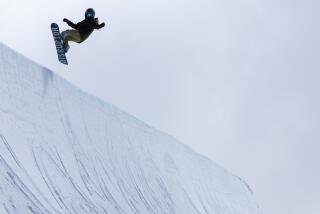Seeking to lift minority skiers
HUNTINGTON LAKE, CALIF. — Skiers cut through a fresh dusting of snow, then grind to a halt at the icy base of the Sierra Summit resort where Richard Shimizu is taking a break.
Although the ski resort is in Fresno County, where almost half the population are minorities, most people crunching past Shimizu in their ski boots are white. It’s a scene repeated in ski resorts across the country, where only 3 out of 20 skiers or snowboarders are part of a minority, according to marketing researchers.
“You see some Asian people sometimes, but few blacks and few Hispanics,” said Shimizu, who is Japanese American. “It’s changing, but still there’s a big difference. We used to never think about things like ethnicity. Now people pay more attention.”
After years of stagnation in the 1990s, when the number of days skiers and snowboarders spent on the slopes stayed the same even as the population grew, some resorts are trying to attract ethnic groups not traditionally tied to the sport, hoping to tap into a growing market segment.
As the nation’s demographic profile changes, the industry’s future lies in part in its ability to reach kids whose parents don’t ski -- and who may have never seen snow before, said Bill Jensen, an executive with Vail Resorts Inc. and incoming chairman of the National Ski Areas Assn., which represents 332 alpine resorts.
“These groups are the fastest-growing population segments in the country,” Jensen said of minorities. “With the aging of the baby boom generation, this is what our customers will look like in 20, 30 years.”
Resorts are advertising in Chinese-language newspapers, translating brochures into Spanish, stocking smaller boots Asians might need and introducing children from rural schools or urban centers to a sport they may have seen only on TV.
Change has been slow on the slopes, but it’s happening. In 1999-2000, minorities made up 10% of skiers or snowboarders, but figures for this year indicate that the number has grown to about 15%, according to surveys by the LeisureTrends Group, a Colorado market research firm.
Sierra Summit has put out information in Spanish and has Spanish-speaking ski instructors. By working with schools in the San Joaquin Valley, the resort is bringing in a steady stream of youngsters who grew up just out of reach of the snowcapped peaks.
For $20 a day, students from towns best known for their orange or lettuce crops get a ski or snowboarding lesson, equipment, lunch and a lift ticket -- a package executives at the resorts hope will give them a taste for snow.
“These kids, it’s not that they wouldn’t enjoy it, it just isn’t in their culture,” said Boomer Devaurs, marketing manager at Sierra Summit. “It’s our hope they’ll come back and bring their families.”
About 2,500 students try skiing or snowboarding under that program each season -- and many of them get hooked, even if they’re clumsy on the first runs.
“It looked easy, but once you got up there, it was hard,” said Priscilla Medina, who was a freshman at Fresno’s Sunnyside High School last spring when she tried out -- and loved -- snowboarding.
Her parents don’t ski and come to the snow only “once in a great while,” she said. Priscilla said she planned to come back.
In Colorado, a similar program is aimed at building a connection between urban kids and some of the most exclusive ski resorts in the country. Places such as Aspen and Vail traditionally draw international visitors undaunted by spending big money to hit the slopes in style. It’s an appeal that has largely eluded minorities in nearby Denver. Jensen said only about 5% of Vail’s guests were minorities.
The cost of skiing at an elite destination resort coupled with the hassle factor -- figuring out where to go or what equipment is necessary -- has worked to create a gap between Denver’s Latino population and Vail that is much wider than the 100 miles that separate them, said Roberto Moreno, founder of Alpino, an organization dedicated to diversifying the slopes.
Working with Vail, Keystone, Beaver Creek and Breckenridge, Alpino has brought about 4,000 youngsters to the mountains each year, giving them all they need for a day on the snow for $22.50.
“A lot of resorts are recognizing that if they don’t reach out to people of color, they’re going to be losing a lot of business,” Moreno said.
The resorts have sculpted terrain parks -- essentially skate parks for snowboarders -- that come closer to the experiences of big-city kids, said Jensen, co-president of Vail Resorts Mountain Division, which includes the four Colorado resorts and Heavenly Valley at Lake Tahoe.
“They have a very urban feel,” he said. “That connection is easier for people to make than putting inner-city kids on skis.”
It’s that connection that resorts are trying to build. Once new customers are hooked, they’ll put in the effort -- and the money -- to come back, resort representatives said.
It worked for Dietrich Goodwin, a Fresno high school senior who went snowboarding with the Sierra Summit program.
“Yeah, I’ll come back,” he said. “The speed you catch coming down the mountain -- it’s kind of like skateboarding ... but you can go so much faster. It’s cool.”
More to Read
Inside the business of entertainment
The Wide Shot brings you news, analysis and insights on everything from streaming wars to production — and what it all means for the future.
You may occasionally receive promotional content from the Los Angeles Times.










